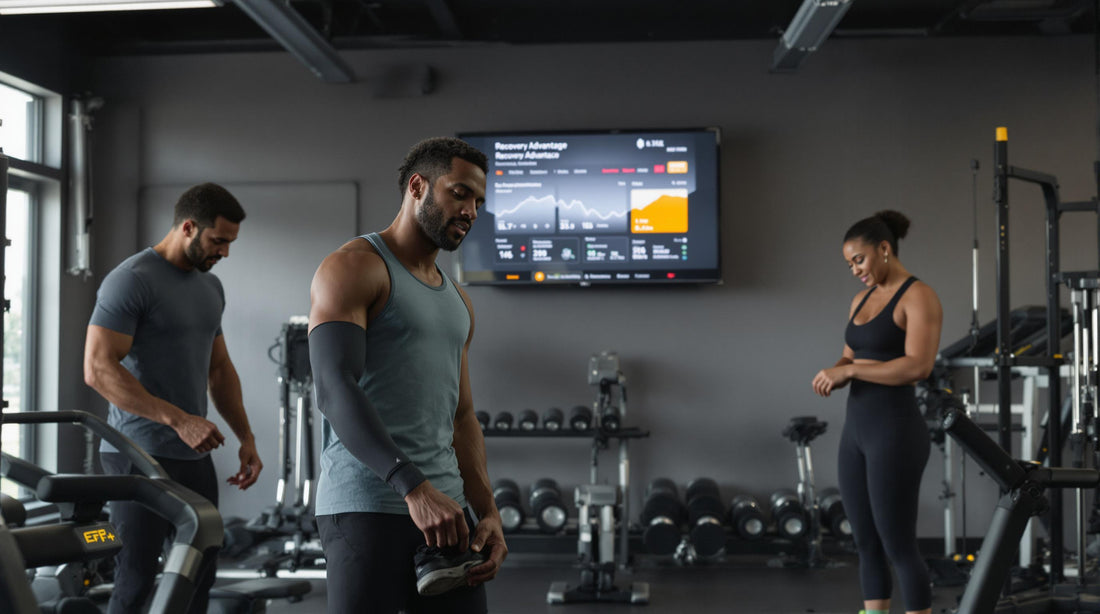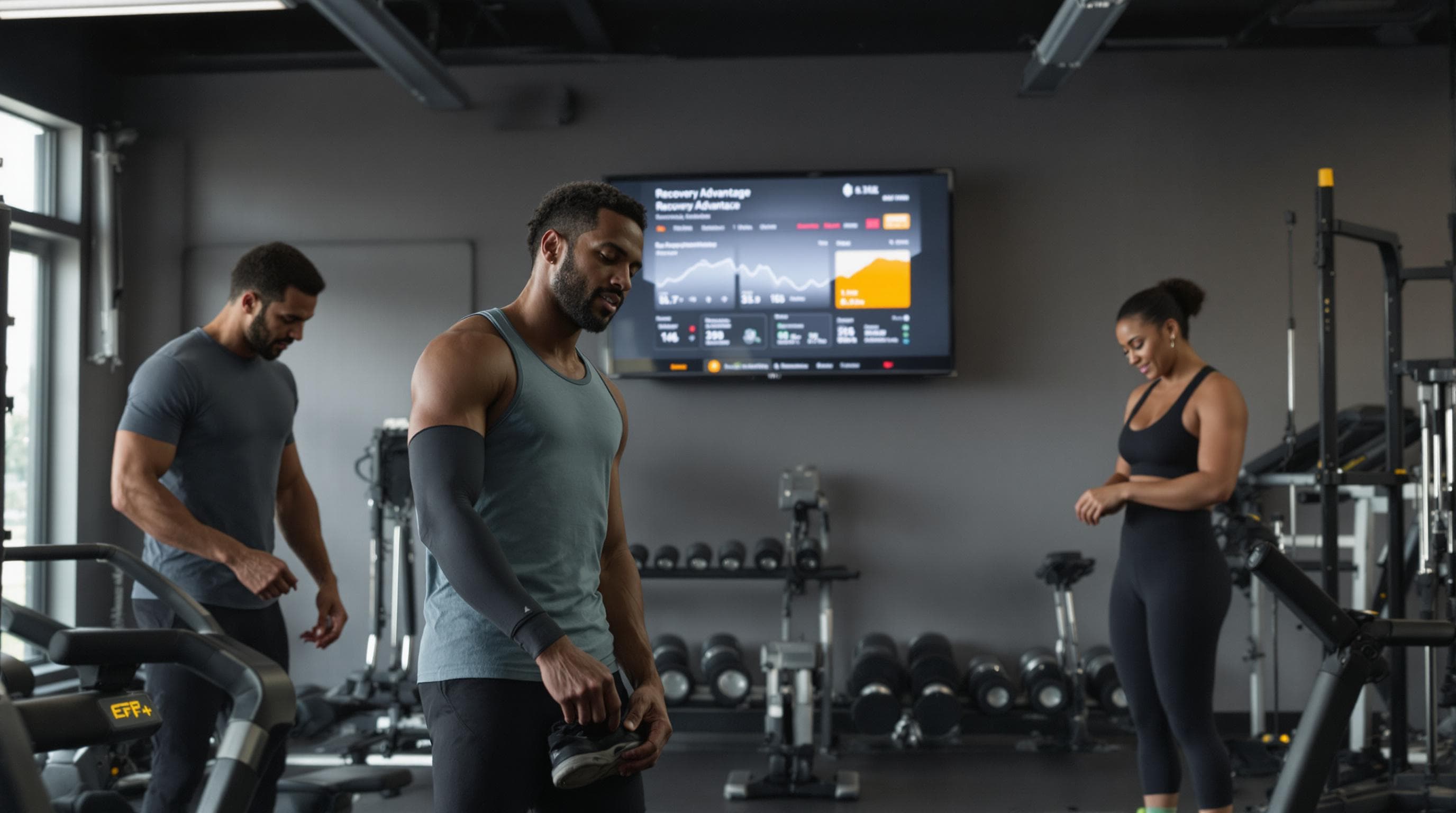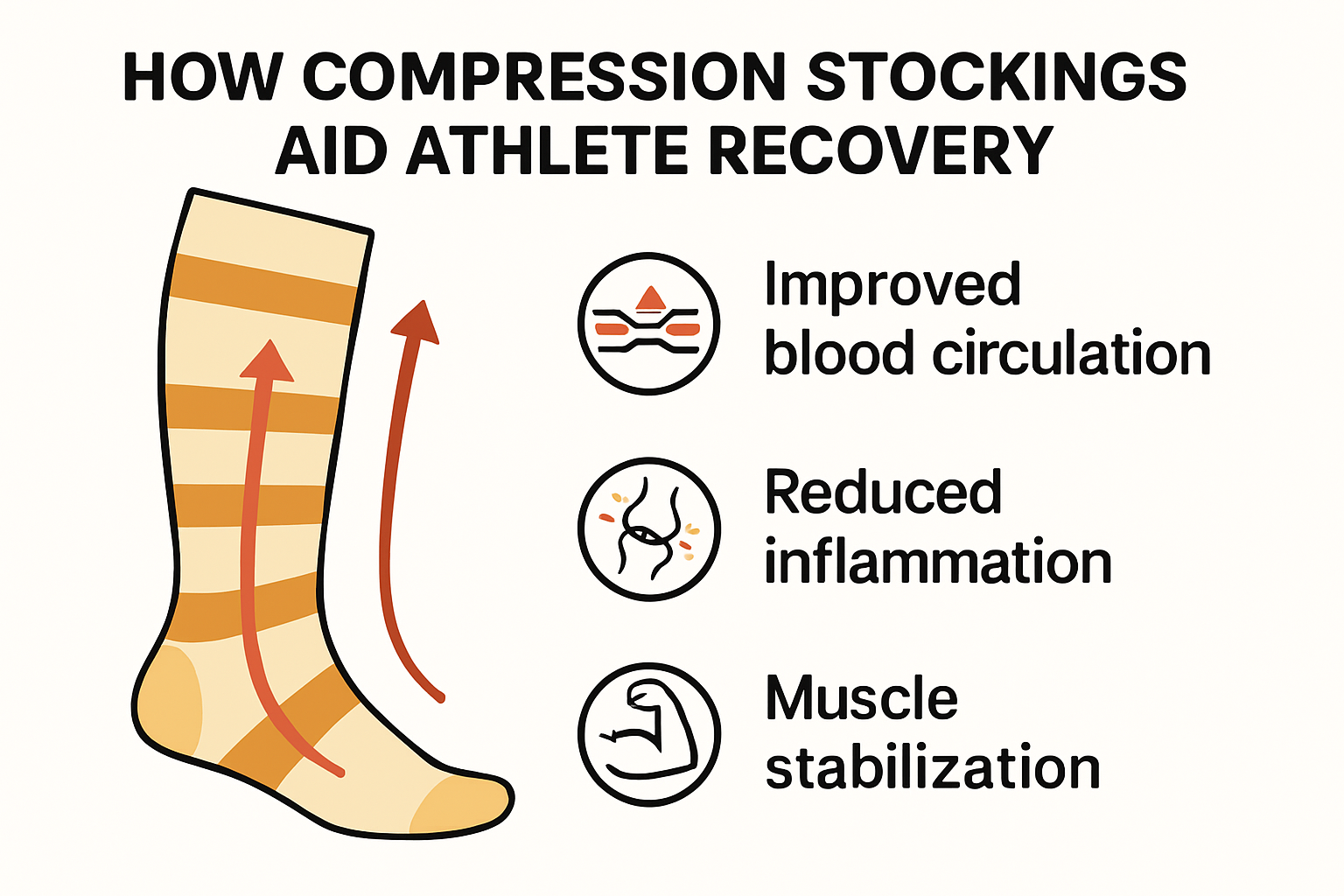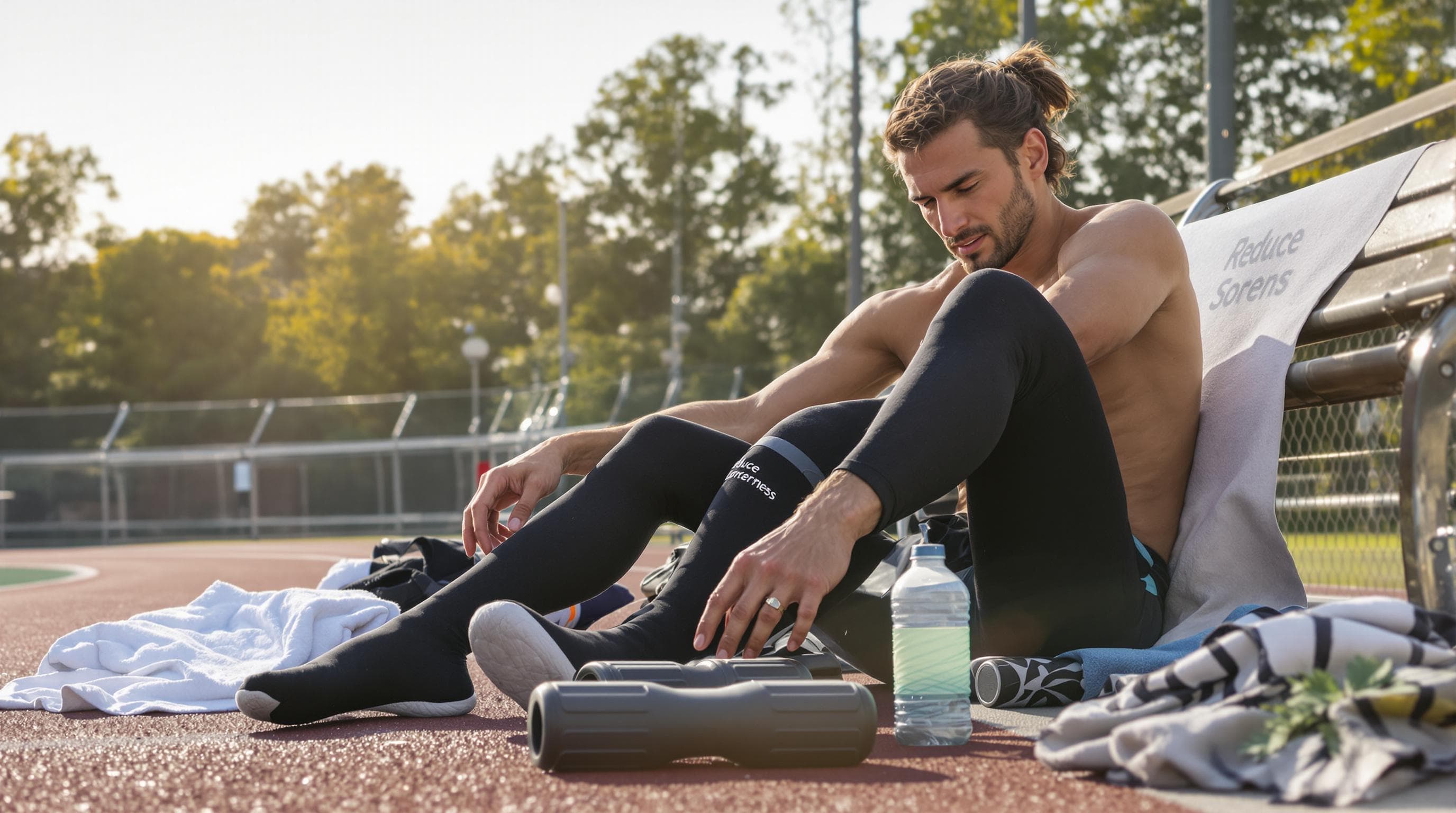
Compression Stockings for Athletes: 2025 Guide to Better Health
Share

Athletes are always searching for that extra edge when it comes to faster recovery and better performance. Up to 70 percent of competitive runners now use compression stockings to cut down muscle soreness and speed up healing. Surprising, right? Most people imagine these stockings are only for people in hospitals or with medical problems, not for peak fitness. Turns out, they’re a science-backed tool for everyone from weekend warriors to pro competitors and might just be the health upgrade you never expected in your training bag.
Table of Contents
- How Compression Stockings Help Athletes Recover
- Muscle Recovery And Reduced Inflammation
- Performance And Perceived Muscle Soreness
- Strategic Recovery And Long-Term Athletic Health
- Choosing The Right Compression Level And Fit
- Understanding Compression Levels
- Measuring For The Perfect Fit
- Sport-Specific Compression Considerations
- Compression Stockings For Special Health Needs
- Adaptive Athletes And Mobility Challenges
- Managing Chronic Health Conditions
- Specialized Support For Unique Physiological Needs
- Tips For Safe And Effective Daily Use
- Proper Application And Wearing Techniques
- Maintenance And Care Guidelines
- Potential Risks And Precautionary Measures
Quick Summary
| Takeaway | Explanation |
|---|---|
| Graduated Pressure Enhances Recovery | Compression stockings apply graduated pressure to improve blood circulation, reduce muscle inflammation, and accelerate muscle healing post-exercise, thereby decreasing post-workout fatigue. |
| Choosing the Right Fit is Critical | Precise measurement of leg circumference and individual sport requirements are essential for selecting compression levels (typically 15-30 mmHg) to maximize performance and recovery benefits. |
| Support for Health Conditions | Compression stockings offer therapeutic benefits for individuals with chronic health issues, such as diabetes or lymphedema, by improving circulation and reducing swelling, making them valuable for both athletes and those with special health needs. |
| Proper Application and Care are Essential | Correct application techniques and regular maintenance, such as washing and inspection for wear, are crucial for ensuring the effectiveness and longevity of compression stockings. |
| Be Aware of Potential Risks | Individuals with specific medical conditions should consult healthcare providers before use, as ill-fitting stockings can cause discomfort or exacerbate health issues. |
How Compression Stockings Help Athletes Recover
Athletes constantly push their bodies to the limit, making recovery an essential aspect of maintaining peak performance. Compression stockings have emerged as a crucial tool in the athletic recovery process, offering multiple physiological benefits that support muscle healing and reduce post-exercise fatigue.

Muscle Recovery and Reduced Inflammation
Compression stockings work by applying graduated pressure to the legs, which helps improve blood circulation and reduce muscle inflammation after intense physical activity. Research from the National Institutes of Health revealed that compression garments can significantly impact muscle recovery indicators. By promoting better blood flow, these stockings help remove metabolic waste products more efficiently, reducing muscle soreness and accelerating the healing process.
The mechanism is straightforward yet powerful. When athletes wear compression stockings, the graduated pressure helps support venous return, which means blood flows more effectively from the lower extremities back to the heart. This process reduces swelling, minimizes muscle vibration during exercise, and helps prevent micro-tears in muscle fibers that can occur during intense training.
Performance and Perceived Muscle Soreness
Beyond physical recovery, compression stockings play a critical role in an athlete’s perception of muscle fatigue and overall performance. A comprehensive study published in sports medicine research demonstrated that athletes wearing compression stockings during and after simulated trail races experienced reduced leg soreness and improved muscle function indicators.
This research highlights the psychological and physiological benefits of compression technology. Athletes report feeling less muscle pain and experiencing faster recovery times. The consistent pressure provided by these stockings helps stabilize muscles, reduce oscillation during movement, and potentially decrease the risk of muscle strain.
Strategic Recovery and Long-Term Athletic Health
Compression stockings are not just a temporary solution but a strategic approach to athletic recovery. They support the body’s natural healing processes by maintaining consistent pressure on muscle groups, which can help prevent delayed onset muscle soreness (DOMS) and reduce overall recovery time. Athletes from various disciplines - runners, cyclists, basketball players, and weightlifters - have incorporated compression stockings into their recovery protocols.

For optimal results, athletes should consider the specific compression level and fit. Medical-grade compression stockings typically range from 15-30 mmHg, with higher pressures providing more intense support. Learn more about choosing the right compression level for athletic recovery.
Ultimately, compression stockings represent a sophisticated approach to athletic recovery. They combine biomechanical support, enhanced circulation, and targeted muscle stabilization to help athletes perform at their best and recover more efficiently. By understanding and leveraging these benefits, athletes can potentially reduce injury risks and maintain consistent training momentum.
Choosing the Right Compression Level and Fit
Selecting the appropriate compression stocking is a nuanced process that goes beyond simple sizing. Athletes require precise compression levels and fits to maximize performance and recovery benefits while avoiding potential discomfort or reduced effectiveness.
Understanding Compression Levels
Compression stockings are measured in millimeters of mercury (mmHg), which indicates the pressure applied to the legs. For athletes, this measurement is critical in determining the right level of support. Research from the Journal of Strength and Conditioning Research revealed that different compression levels can significantly impact athletic performance and recovery.
Typical compression levels range from mild (8-15 mmHg) to medical-grade (20-30 mmHg). Athletes should consider their specific sport, training intensity, and individual physiology when selecting compression levels. Lower pressures around 12-15 mmHg can be suitable for general recovery and light training, while more intense athletes might benefit from medium compression (18-21 mmHg).
Below is a table summarizing the common compression levels for athletes, recommended uses, and important considerations.
| Compression Level (mmHg) | Typical Use Case | Recommended For | Important Considerations |
|---|---|---|---|
| 8-15 | Mild support | Everyday wear, mild fatigue | Gentle compression, suitable for most users |
| 12-15 | Light training, general recovery | Recreational athletes | May not be enough for intense activity |
| 15-20 | Moderate recovery, prevention | Runners, fitness enthusiasts | Good balance of support and comfort |
| 18-21 | Post-training recovery | Higher intensity athletes | May cause discomfort if not sized properly |
| 20-30 (Medical-grade) | Advanced recovery, special health needs | Competitive athletes, medical conditions | Must consult healthcare provider; higher pressure can cause discomfort if not properly fitted |
Measuring for the Perfect Fit
Precision in sizing is paramount. Ill-fitting compression stockings can reduce their effectiveness and potentially cause discomfort. Research indicates that compression pressures exceeding 18 mmHg at the ankle can lead to increased perceived pain and decreased comfort during exercise.
To ensure optimal fit, athletes should:
- Measure their leg circumference at multiple points (ankle, calf, thigh)
- Consider body weight and muscle mass
- Consult size charts specific to compression stocking brands
- Consider trying on multiple sizes to find the most comfortable option
Sport-Specific Compression Considerations
Different athletic disciplines require unique compression approaches. Runners might prioritize lower leg support, while cyclists could benefit from full-leg compression. Learn more about selecting sport-specific compression solutions.
Endurance athletes often require different compression strategies compared to power athletes. Factors like muscle group, training frequency, and recovery needs play crucial roles in selecting the right compression level. Some athletes may use different compression levels for training versus recovery periods.
It’s crucial to remember that compression stockings are not a one-size-fits-all solution. Individual body mechanics, training intensity, and personal comfort should guide the selection process. Consulting with sports medicine professionals or experienced athletic trainers can provide personalized recommendations tailored to specific athletic needs.
Ultimately, the right compression stocking can be a game-changing tool in an athlete’s recovery and performance toolkit. By understanding compression levels, prioritizing proper fit, and considering individual athletic requirements, athletes can leverage these garments to optimize their physical potential.
Compression Stockings for Special Health Needs
Compression stockings extend far beyond traditional athletic recovery, offering critical support for individuals with specific health conditions and unique physiological challenges. These specialized garments provide targeted therapeutic benefits for people managing complex medical needs.
Adaptive Athletes and Mobility Challenges
Research from the Journal of Spinal Cord Medicine revealed significant benefits of compression socks for elite wheelchair athletes, demonstrating improved submaximal performance and increased post-exercise arm blood flow. For adaptive athletes with limited mobility, compression stockings can be transformative, helping manage circulation, reduce muscle fatigue, and support overall physical performance.
Individuals with neurological conditions, partial paralysis, or reduced limb mobility often struggle with circulation and muscle support. Compression stockings provide consistent pressure that helps stimulate blood flow, reduce swelling, and minimize the risk of blood clots. The graduated compression design is particularly beneficial, promoting venous return and preventing fluid accumulation in lower extremities.
Managing Chronic Health Conditions
Compression stockings play a crucial role in managing various chronic health conditions. Learn more about specialized compression solutions for different health needs. Patients with diabetes, lymphedema, and circulatory disorders can significantly benefit from targeted compression therapy.
Below is a table summarizing the ways compression stockings support different chronic health conditions as mentioned in the content.
| Health Condition | Compression Stocking Benefits |
|---|---|
| Diabetes | Improves blood circulation, reduces risk of peripheral edema, minimizes nerve damage, supports wound healing |
| Lymphedema | Reduces swelling, improves lymphatic drainage, prevents fluid buildup and infection |
| Circulatory Disorders | Promotes healthy blood flow, reduces risk of blood clots and swelling |
| Neurological Conditions (e.g., partial paralysis) | Stimulates blood flow, minimizes swelling, prevents blood clots |
| Reduced Mobility | Supports venous return, prevents fluid accumulation in lower extremities |
For diabetic patients, compression stockings help prevent lower limb complications by:
- Improving blood circulation
- Reducing the risk of peripheral edema
- Minimizing nerve damage potential
- Supporting wound healing processes
Patients with lymphedema experience reduced swelling and improved lymphatic drainage through carefully selected compression garments. The strategic pressure helps move excess fluid, preventing painful buildup and reducing the risk of infections.
Specialized Support for Unique Physiological Needs
Scientific research in Sports Medicine indicates that compression garments can provide muscle function support beyond traditional athletic applications. For individuals with conditions like multiple sclerosis, cerebral palsy, or recovering from stroke, compression stockings offer critical muscular and circulatory support.
High-risk patients requiring extended periods of immobility - such as those recovering from surgery or managing chronic conditions - can use compression stockings to prevent deep vein thrombosis and promote healthy blood circulation. The graduated pressure design helps counteract the effects of prolonged sitting or bed rest.
Precision is key when selecting compression stockings for special health needs. Medical professionals often recommend specific compression levels (typically ranging from 15-30 mmHg) based on individual health assessments. Patients should always consult healthcare providers to determine the most appropriate compression level and style for their specific condition.
Compression stockings represent more than just a medical accessory - they are a sophisticated therapeutic tool designed to improve quality of life. By understanding individual health requirements and leveraging advanced compression technology, individuals with diverse physiological challenges can find supportive solutions that enhance mobility, comfort, and overall well-being.
Tips for Safe and Effective Daily Use
Navigating the world of compression stockings requires more than just understanding their benefits. Proper usage, maintenance, and application are crucial to maximizing their therapeutic potential and ensuring long-term effectiveness.
Proper Application and Wearing Techniques
Research from the Journal of Strength & Conditioning Research highlights the importance of correct application for optimal performance benefits. Putting on compression stockings requires specific techniques to maintain their integrity and ensure proper pressure distribution.
To apply compression stockings effectively:
- Ensure hands are clean and dry
- Turn the stocking inside out up to the heel
- Gently pull the stocking over the foot and heel
- Slowly unroll the stocking up the leg, smoothing out wrinkles
- Avoid bunching or folding, which can create uneven pressure points
Timing is also critical. Athletes and individuals with specific health needs should consult healthcare professionals about the ideal duration of daily wear. Typically, compression stockings are recommended for 8-12 hours during active periods, with careful monitoring of skin condition and comfort.
Maintenance and Care Guidelines
A systematic scoping review emphasizes the importance of proper garment maintenance to preserve compression effectiveness. Compression stockings require specialized care to maintain their therapeutic properties and extend their lifespan.
Key maintenance practices include:
- Wash after each use with mild soap and lukewarm water
- Avoid using harsh detergents or fabric softeners
- Air dry flat, away from direct heat or sunlight
- Replace stockings every 3-6 months or as recommended by manufacturers
- Inspect regularly for signs of wear, stretching, or damage
Discover more about comprehensive compression stocking care, including specific washing techniques and preservation methods.
Potential Risks and Precautionary Measures
While compression stockings offer numerous benefits, they are not without potential risks. Individuals with certain medical conditions should exercise caution and seek professional medical advice before use. Potential contraindications include:
- Advanced peripheral arterial disease
- Severe peripheral neuropathy
- Active skin infections
- Untreated open wounds
- Severe cardiovascular conditions
Users should monitor their skin for signs of irritation, such as redness, increased pain, or changes in skin color. If any adverse reactions occur, discontinue use and consult a healthcare professional. Proper sizing is crucial - ill-fitting compression stockings can cause discomfort or potentially exacerbate existing health conditions.
Compression stockings represent a sophisticated approach to health management, requiring informed and careful use. By understanding application techniques, maintaining garment quality, and being aware of potential risks, users can safely leverage the therapeutic benefits of these specialized garments. Always prioritize individual health needs and professional medical guidance when incorporating compression stockings into daily routines.
Frequently Asked Questions
What are compression stockings and how do they benefit athletes?
Compression stockings are specialized garments that apply graduated pressure to the legs, enhancing blood circulation, reducing inflammation, and aiding in muscle recovery post-exercise, ultimately decreasing post-workout fatigue.
How do I choose the right compression level for my needs?
Compression levels are measured in mmHg, ranging from 8-30 mmHg. For athletes, levels like 15-20 mmHg are recommended for moderate recovery, while higher levels (20-30 mmHg) are suitable for intense support. Consider the intensity of your activity and consult size charts for the best fit.
Can compression stockings help with chronic health conditions?
Yes, compression stockings can support individuals with chronic health issues like diabetes and lymphedema. They improve circulation, reduce swelling, and assist with lymphatic drainage, making them beneficial for both athletes and those with special health needs.
How should I care for my compression stockings?
To maintain the effectiveness of compression stockings, wash them after each use with mild soap and lukewarm water, avoid harsh detergents, air dry them, and inspect regularly for wear. Replace them every 3-6 months or as advised by the manufacturer.
Optimize Your Performance and Recovery With Fit Stockings
Serious athletes know that recovery is just as important as training. If you are dealing with muscle soreness, lingering fatigue, or are struggling to find the right compression level and fit to support your performance goals, it is time to take action. Our article highlighted how targeted compression can speed up healing, decrease post-workout soreness, and provide essential support for both athletic recovery and long-term health. Do not let uncomfortable or poorly fitting gear slow you down when your body deserves the best.
Discover the specialized solutions trusted by professionals by exploring our Jobst collection for premium, medical-grade compression stockings designed specifically for athletes and those with demanding recovery needs. Shop with confidence at Fit Stockings and experience free shipping, easy returns, and the perfect blend of performance, comfort, and support. Take the next step for your health and training by choosing the right compression stockings today.
Recommended
- The Ultimate Guide to Compression Stockings: Comfort, Health, and Styl – Fit Stockings
- Knee High Compression Stockings: Health Benefits and Guide 2025 – Fit Stockings
- Compression Stockings and Diabetes: What to Know in 2025 – Fit Stockings
- Compression Stockings for Athletes: Boosting Performance and Recovery – Fit Stockings

